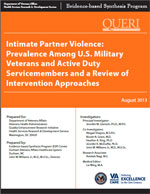
|
Principal Investigator:
Jennifer M. Gierisch, Ph.D., M.P.H. |
Download PDF: Complete Report, Executive Summary, Report, Appendices
In the United States, intimate partner violence (IPV) poses a significant public health burden that affects both men and women. Over a third (35.6%) of women and a fourth (28.5%) of men in the United States have experienced rape, physical violence, or stalking by an intimate partner in their lifetime. Outcomes associated with IPV include a wide range of social, physical, and mental issues such as family dissolution, adverse pregnancy outcomes, mental health issues (depression, posttraumatic stress disorder [PTSD], anxiety), incarceration, and death. IPV affects many facets of society including medical, mental health, social services, and criminal justice systems. Moreover, productivity losses and costs attributable to IPV are significant.
Military service has unique psychological, social, and environmental factors that may contribute to elevated risk of IPV among active duty servicemembers and Veterans. Multiple deployments, family separation and reintegration, demanding workloads at home and while on duty, histories of head trauma, mental illness, and substance abuse can contribute to partner conflict and elevated risk of IPV among active duty servicemembers, Veterans, and their intimate partners.
Currently the VA does not have a comprehensive national program to address IPV. Thus, the VA convened the Domestic Violence Task Force to define the scope of, and design a plan for evaluating domestic violence among Veterans. In order to support the goals and mission of this task force, the Durham VA Evidence-based Synthesis Program conducted a systemic review of the literature to synthesize the evidence on the prevalence of IPV among active duty servicemembers and Veterans and to conduct an evidence synthesis of the systematic review (SR) literature on intervention strategies to address IPV.
A Systematic Review: Intimate Partner Violence among Veterans and Active Duty Service Members (VA HSR&D Management e-Brief)